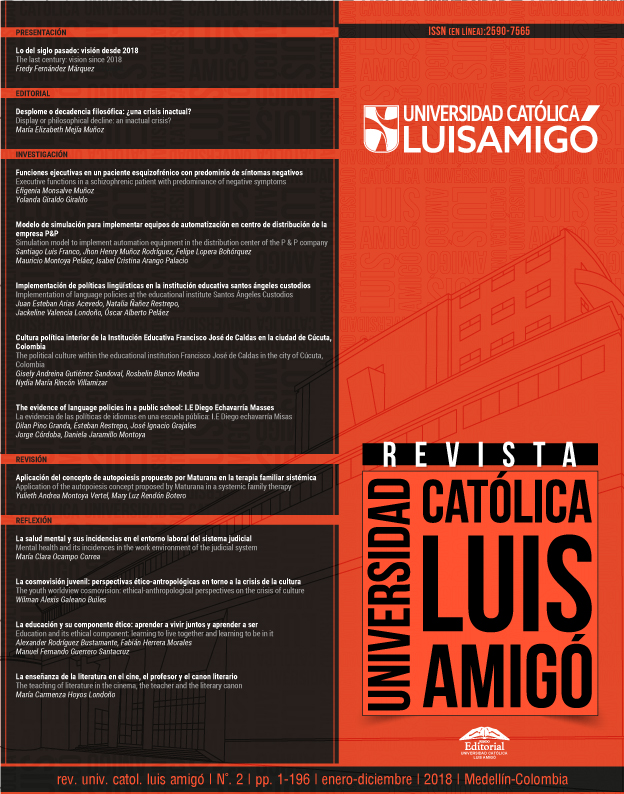The teaching of literature in the cinema, the teacher and the literary canon
DOI:
https://doi.org/10.21501/25907565.3051Keywords:
Teacher, Master cinema, Literature, Poetry, Shakespeare.Abstract
For decades, the cinema has constructed varied images of teachers with performances at all educational levels and with different institutionalized knowledge. Among them are those of the literature teacher. The cinematographic exhibition consists of 18 films, dramas and comedies, produced between 1951 and 2009. The observation of the films was made through the concept of cinematographic enunciation of Christian Metz. This text talks about the masters of literature in contemporary cinema, the way they teach literature and their literary canon.Downloads
References
Aristarain, A. (Director). (2002). Lugares comunes [Película]. Argentina: Coproducción Argentina-España; Adolfo Aristaráin / Tornasol Films / Shazam S.A. / Pablo Larguia Producciones.
Asquith, A. (Director). (1951). La versión Browning [Película]. Reino Unido: The Rank Organisation.
Attenborough, R. (Director). (1993). Tierra de penumbras [Película]. Reino Unido: Savoy Pictures / Spelling Films International / Price Entertainment.
Baumbach, N. (Director). (2005). Historias de familia [Película]. Estados Unidos: Samuel Goldwyn Films.
Bloom, H. (2001). Shakespeare. La invención de lo humano. En T. Segovia (trad.). 1ª edición. Bogotá, Colombia: Grupo Editorial Norma.
Brooks, R. (Director). (1955). Semilla de maldad [Película]. Estados Unidos: MGM.
Cantet, L. (Director). (2008). La clase [Película]. Francia: Haut et Court.
Eco, U. (1993). Lector in fabula. Barcelona, España: Editorial Lumen.
Escobar, A. (2003). Literatura y cine. Una tradición de pasiones encontradas. Medellín, Colombia: Editorial Comfama.
Ford, T. (Director). (2009). Un hombre solo [Película]. Estados Unidos: Artina Films / Depth of Field / Fade to Black Productions.
Gilbert, L. (Director). (1983). Educando a Rita [Película]. Reino Unido: Acorn Pictures.
Hanson, C. (Director). (2000). Jóvenes prodigiosos. Estados Unidos: Paramount Pictures / Mutual Film Company.
Hytner, N. (Director). (2006). The History Boys. Reino Unido: BBC / Free Range Films / DNA Films. Distribuida por Fox Searchlight.
Kaye, T. (Director). (1998). Historia americana x. Estados Unidos: New Line Cinema.
Kurosawa, A. (Director). (1993). Madadayo. Japón: Kurosawa Production Co. / Dentsu / Tokuma Shoten / Daiei Motion Picture Company.
LaGravenese, R. (Director). (2007). Escritores de la libertad. Estados Unidos: Paramount Pictures / MTV Films / Jersey Films / Double Feature Films.
Larrosa, J. (1998). Venenos y antídotos. En: La experiencia de la lectura. Estudios sobre literatura y formación. Barcelona, España: Laertes.
Loscertales, F. (1999). Estereotipos y valores de los profesores en el cine. Revista Comunicar, 12, 37-45.
Marshall, P. (Director). (1994). Un poeta entre reclutas. Estados Unidos: Cinergi Pictures Entertainment / Parkway Productions / Touchstone Pictures.
Metz, C. (1972). Ensayos sobre la significación en el cine. Argentina: Tiempo Contemporáneo.
Parker, A. (Director). (1999). Las cenizas de Ángela. Estados Unidos: Coproducción Estados Unidos-Irlanda; Universal Studios Home Entertainment / Paramount Pictures.
Quique, I. (2018). Vida y muerte de Federico García Lorca. España. Ediciones Castellano.
Smith, J. (Director). (1995). Mentes peligrosas. Estados Unidos: Don Simpson, Jerry Bruckheimer Films / Vía Rosa Productions.
Truffaut, F. (Director). (1959). Los 400 golpes. Francia: Les Films du Carrosse.
Weir, P. (Director). (1989). La sociedad de los poetas muertos. Estados Unidos. Touchstone Pictures/Silver Screen Partners IV.
Downloads
Published
How to Cite
Issue
Section
License
PROPIEDAD INTELECTUAL
Los autores son moral y legalmente responsables del contenido de sus artículos, así como del respeto a los derechos de autor. Por lo tanto, éstos no comprometen en ningún sentido a la Universidad Católica Luis Amigó.
La reproducción de los artículos se regirá conforme a lo descrito en http://creativecommons.org/licenses/by-nc-sa/4.0/

